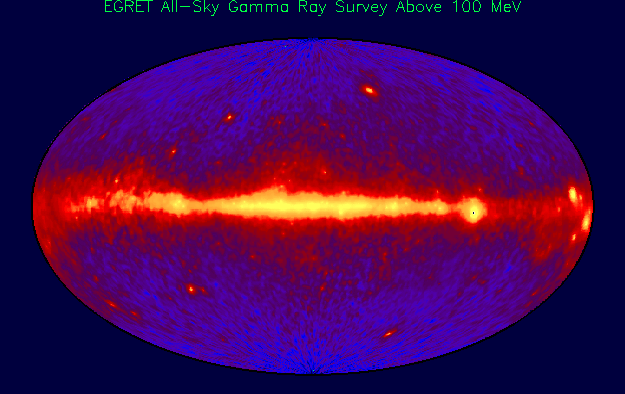
 Credit: Compton Gamma Ray Observatory Team
Credit: Compton Gamma Ray Observatory Team
The Universe at 100 MeV
The Compton Gamma Ray
Observatory (CGRO) is the second of NASA's "Great Observatories" (the
first being the Hubble Space Telescope). The Energetic Gamma Ray
Experiment Telescope (EGRET) provides the highest energy gamma-ray
window for CGRO. EGRET's energy range is from 30 million electron volts (30
MeV) to 30 billion electron volts (30 GeV). EGRET is 10 to 20 times larger
and more sensitive than previous detectors operating at these high energies
and has made detailed observations of high energy processes associated with
diffuse gamma-ray emission, gamma-ray bursts, cosmic rays, pulsars, and
active galaxies known as gamma-ray blazars. The image above is an all-sky
map in Galactic coordinates obtained by EGRET of gamma-ray emission at
energies above 100 MeV. The brightest emission is colored yellow in this
false-color image, while the faintest emission is blue. The plane of the
Milky Way galaxy is clearly seen as a strong source of diffuse and resolved
emission. The diffuse emission in the galactic plane is primarily due to
cosmic ray interactions with the interstellar medium. The Vela, Geminga,
and Crab pulsars are clearly visible as bright knots of emission in the
galactic plane in the right portion of the slide. The gamma-ray blazar
3C279 is seen as the brightest knot of emission above the plane. This map
was produced by combining EGRET observations from the first year of Compton
Observatory operations. More information can be found at the CGRO Science Support
Center website.
Last Week *
HEA Dictionary * Archive
* Search HEAPOW
* Education
Each week the HEASARC
brings you new, exciting and beautiful images from X-ray and Gamma ray
astronomy. Check back each week and be sure to check out the HEAPOW archive!
Page Author: Dr. Michael F.
Corcoran
Last modified November 6, 2001


